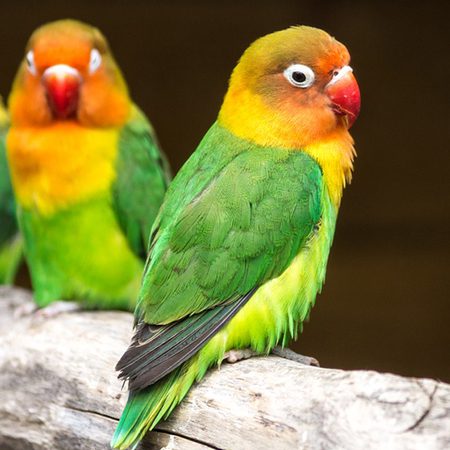Lovebird
Agapornis
Here at camp we have Peach-faced lovebirds, also known as rosy-faced lovebirds. Their scientific genus name literally means love bird in Greek. Agape means love while ornis means bird. The species name roseicollis means rose-collared, another name for this species of lovebird. This is one of nine species of lovebirds in the world, though only 3 are used for pets (the other two are the Masked and the Fischers lovebirds). Peach-faced lovebirds got their name very obviously; the feathers on their face are traditionally red or pinkish in color.
The hue and coverage of these feathers can vary per bird. Because they are used in the pet trade a lot, there are many other colorations now. They can be green, yellow, black, blue, and more in body color; usually they all retain the same color face, though white faces also occur. These are very social birds with each other and with humans as well. When food is abundant, flocks of over 100 of these birds have been seen. They are considered to have high intelligence, though they do not learn to mimic human speech. Rather, they can mimic noises like whistles. They are very small birds, only weighing 1-2 oz, are about 6 in long, and have a 4 in wingspan. In captivity, they have been shown to live between 15 and 25 years old.

The Lovebird genus is spread out throughout Central Africa and parts of Tanzania.
HABITAT -They prefer dry areas with permanent standing water near deserts and woodlands.
DIET -These birds mainly eat seeds, occasionally flowers.
FUN FACT -Large groups of love birds will mob together to fight off predators.
SOCIAL BEHAVIOR -They are very social, living in flocks of up to 30 birds.
ACTIVITY -They are diurnal being most active during the day and resting during the evening.
PREDATORS -Predators include birds of prey and other large carnivores.
SIZE -They only weigh 1-2 oz and are about 5 in long.
RELATIVES -They are related to other parrot species such as the African Gray and Indian Ringneck.
CONSERVATION -They are catergorized as LC (Least Concern) by the IUCN.
Cub Creek Animal Care Information
Housing - Our lovebirds live in the Habitats room in a spacious enclosure with two of our lemurs. Their enclosure has several trees and many interconnection branches to create places to explore and perch on. They also have a nest box to sleep in as well as a window that allows them to see what is going on outside.
Diet - These birds are fed ZuPreem FruitBlend medium bird pellets that give them all the vitamins and nutrients they need to be healthy. They also get fresh bird salad daily, which includes apple, shredded sweet potato, and greens. They are also given access to fresh water daily.
Enrichment - Their multi-species enclosure (with lemurs and another bird species) provides enrichment through daily interactions and get to play with toys that are made for the others. Campers can use cardboard, twine, and pretty much anything we can find to make hanging toys that can have food hidden in them or just used to swing on!


